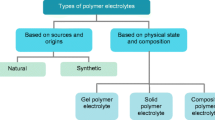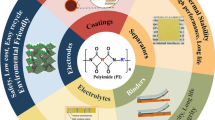Abstract
Biodegradable solid polymer electrolytes based on PVA (polyvinyl alcohol) and amino acid (proline) with different molar mass percentages of ammonium chloride (NH4Cl) were prepared by solution-casting technique using distilled water as solvent. Their structural, thermal, vibrational, and electrical properties were studied. XRD analysis confirms the amorphous nature of the polymer electrolytes. DSC measurements show a decrease in Tg with increasing salt concentration. The FTIR analysis reveals the complex formation between the PVA, proline, and ammonium chloride. Transference numbers for the proton-conducting polymer electrolytes have been measured. The maximum ionic conductivity has been found to be 7.01 × 10−4 S/cm at ambient temperature for 75 Mwt% PVA;25 Mwt% proline:0.3 (m.m.%) of NH4Cl polymer electrolyte using AC impedance analyzer. The temperature-dependent conductivity of the polymer membranes obeys Arrhenius behavior. The highest ionic conductivity polymer electrolyte has low activation energy of 0.07 eV among the prepared polymer electrolytes. An electrochemical stability window of 3.10 V has been measured using linear sweep voltammetry for the highest ionic conducting membrane. The highest conductivity polymer electrolyte 75 Mwt% PVA:25 Mwt% proline:0.3 (m.m.%) NH4Cl has been used to construct a primary proton battery and fuel cell.

















Similar content being viewed by others
References
Vinoth Pandi D, Selvasekarapandian S, Bhuvaneswari R, Premalatha M, Monisha S, Arunkumar D, Junichi K (2016) Development and characterization of proton conducting polymer electrolyte based on PVA, amino acid glycine and NH4SCN. Solid State Ionics 298:15–22
Rajendran S, Sivakumar M, Subadevi R (2004) Li–ion conduction of plasticized PVA solid polymer electrolytes complexed with various lithium salts. Solid State Ionics 167:335–339
Ramya CS, Selvasekarapandian S, Hirankumar G, Savitha T, Angelo PC (2008) Investigation on dielectric relaxations of PVP–NH4SCN polymer electrolyte. J Non-Cryst Solids 354:1494–1502
Agrawal SL, Markandey S, Mridula T, Mrigank Mauli D, Kamalesh P (2009) Dielectric relaxation studies on [PEO–SiO2]: NH4SCN nanocomposite polymer electrolyte films. J Mater Sci 44:6060–6068
Priyanka B, Aradhana D (2009) Conductivity study of some polymer electrolytes based on polyacrylonitrile. Ionics 15:711–716
Ramesh S, Wong KC (2009) Conductivity, dielectric behavior and thermal stability studies of lithium ion dissociation in poly (methylmethacrylate)-based gel polymer electrolytes. Ionics 15:249–254
Ramesh S, Ng KY (2009) Characterization of polymer electrolytes based on high molecular weight PVC and Li2SO4. Curr Appl Phys 9:329–332
Radha KP, Selvasekarapandian S, Karthikeyan S, Hema M, Sanjeeviraja C (2013) Synthesis and impedance analysis of proton-conducting polymer electrolyte PVA:NH4F. Ionics 19:1437–1447
Siva devi S, Selvasekarapandian S, Karthikeyan S, Vijaya N, Kingslin Mary Genova F, Sanjeeviraja C (2013) Structural and AC impedance analysis of blend polymer electrolyte based on PVA and PAN. Int J Sci Res 2(10):1–3
Selvasekarapandian S, Hema M, Kawamura J, Kamishima O (2010) Characterization of PVA-NH4NO3 polymer electrolyte and its application in rechargeable proton battery. J Phys Soc Jpn 79:163–168
Radha KP, Selvasekarapandian S (2012) Characterization of PVA: NH4F: ZrO2 composite polymer electrolytes. Int J Sci Res 1:118–119
Rajendran S, Sivakumar M, Subadevi R (2004) Investigations on the effect of various plasticizers in PVA–PMMA solid polymer blend electrolytes. Mater Lett 58:641–649
Hirankumar G, Selvasekarapandian S, Kuwata N, Kawamura J, Hattori T (2005) Thermal, electrical and optical studies on the poly (vinyl alcohol) based polymer electrolytes. J Power Sources 144:262–267
Hema M, Selvasekarapandian S, Arunkumar D, Sakunthala A, Nithya H (2009) FTIR, XRD and AC impedance spectroscopic study on PVA based polymer electrolyte doped with NH4X (X = Cl, Br, I). J Non-Cryst Solids 355:84–90
Ramya CS, Selvasekarapandian S, Savitha T, Hirankumar G (2005) Transport mechanism of Cu-ion conducting PVA based solid polymer electrolyte. Ionics 11:436–441
Hirankumar G, Selvasekarapandian S, Bhuvaneswari MS, Baskaran R, Vijayakumar M (2006) Ag+ ion transport studies in poly vinyl alcolhol based polymer electrolyte system. J Solid State Electrochem 10:193–197
Kingslin Mary Genova F, Selvasekarapandian S, Vijaya N, Siva devi S, Premalatha M, Karthikeyan S (2017) Lithium ion conducting polymer electrolytes based on PVA–PAN doped with lithium triflate. Ionics 23:2727–2734
Sikkanthar S, Karthikeyan S, Selvasekarapandian S, Arunkumar D, Nithya H, Kawamura J (2016) Structural, electrical conductivity and transport analysis of PAN–NH4Cl polymer electrolyte system. Ionics 22:1085–1094
Monisha S, Selvasekarapandian S, Mathavan T, Milton Franklin Benial A, Sindhuja M, Karthikeyan S (2016) Preparation and characterization of biopolymer electrolyte based on cellulose acetate for potential applications in energy storage devices. J Mater Sci Mater Electron 27:9314–9324
Boopathi G, Pugalendhi S, Selvasekarapandian S, Premalatha M, Monisha S, Aristatil G (2016) Development of proton conducting biopolymer membrane based on agar-agar for fuel cell. Ionics 23:2781–2790
Bhuvaneswari R, Karthikeyan S, Selvasekarapandian S, VinothPandi D, Vijaya N, ArunAraichimani, Sanjeeviraja C (2014) Preparation and characterization of PVA complexed with amino acid proline. Ionics 21:387–399
Hodge RM, Edward GH, Simon GP (1996) Water absorption and state of water in semicrystalline poly (vinyl alcohol) films. Polymer 37:1371–1376
Agrawal SL, Arvind A (2004) DSC and conductivity studies on PVA based proton conducting gel electrolytes. Bult Mater Sci 27(6):523–527
Selvalakshmi S, Vijaya N, Selvasekarapandian S, Premalatha M (2017) Biopolymer agar–agar doped with NH4SCN as solid polymer electrolyte for electrochemical cell applications. J Appl Polym Sci 134:44702–44711
Premalatha M, Mathavan T, Selvasekarapandian S, Monisha S, Vinothpandi D, Selvalakshmi S (2016) Investigations on proton conducting biopolymer membranes based on tamarind seed polysaccharide incorporated with ammonium thiocyanate. J Non-Cryst Solids 453:131–140
Sikkanthar S, Karthikeyan S, Selvasekarapandian S, Vinoth Pandi D, Nithya S, Sanjeeviraja C (2014) Electrical conductivity characterization of polyacrylonitrile-ammonium bromide polymer electrolyte system. J Solid State Electrochem 19:987–999
Liew CW, Ramesh S, Arof AK (2014) A novel approach on ionic liquid–based poly (vinyl alcohol) proton conductive polymer electrolytes for fuel cell applications. Int J Hydrog Energy 39:2917–2928
Kingslin Mary Genova F, Selvasekarapandian S, Karthikeyan S, Vijaya N, Pradeepa R, Siva devi S (2015) Study on blend polymer (PVA-PAN) doped with lithium bromide. Polym Sci Ser A 57:851–862
Boukamp BA (1986) A non linear least squares fit procedure for analysis of immittance data of electrochemical systems. Solid State Ionics 20:31–44
Vijaya N, Selvasekarapandian S, Hiran Kumar G, Karthikeyan S, Nithya H, Ramya CS, Prabhu M (2012) Structural, vibrational, thermal, and conductivity studies on proton-conducting polymer electrolyte based on poly (N-vinylpyrrolidone). Ionics 18:91–99
Premalatha M, Vijaya N, Selvasekarapandian S (2016) Characterization of blend polymer PVA–PVP complexed with ammonium thiocyanate. Ionics 22:1299–1310
Vijaya N, Selvasekarapandian S, Sornalatha M, Sujithra KS, Monisha S (2016) Proton-conducting biopolymer electrolytes based on pectin doped with NH4X (X = Cl, Br). Ionics 23(10):2799–2808
Selvasekarapandian S, Baskaran R, Hema M (2005) Complex AC impedance, transference number and vibrational spectroscopy studies of proton conducting PVAc–NH4SCN polymer electrolytes. Physica B 357:412–419
Rajeswari N, Selvasekarapandian S, Sanjeeviraja C, Kawamura J, Asath Bahadur S (2014) A study on polymer blend electrolyte based on PVA/PVP with proton salt. Polym Bull 71(5):1061–1080
Premalatha M, Mathavan T, Selvasekarapandian S, Selvalakshmi S, Monisha S (2017) Incorporation of NH4Br in tamarind seed polysaccharide biopolymer and its potential use in electrochemical energy storage devices. Org Electron 50:418–425
Tan W, Arof AK (2006) Transport properties of hexanoyl chitosan-based gel electrolyte. Ionics 12:149–152
Kadir MFZ, Majid SR, Arof AK (2010) Plasticized–chitosan–PVA blend polymer electrolyte based proton battery. Electrochim Acta 55:1475–1482
Mishra K, Rai DK (2013) Studies of a plasticized PEO + NH4PF6 proton-conducting polymer electrolyte system and its application in a proton battery. J Korean Phys Soc 62:311–319
Monisha S, Mathavan T, Selvasekarapandian S, Milton Franklin Benial A, Aristatil G, Mani N, Premalatha M (2017) Investigation of biopolymer electrolyte based on cellulose acetate-ammonium nitrate for potential use in electrochemical devices. Carbohydr Polym 157:38–47
Author information
Authors and Affiliations
Corresponding author
Rights and permissions
About this article
Cite this article
Hemalatha, R., Alagar, M., Selvasekarapandian, S. et al. Preparation and characterization of proton-conducting polymer electrolyte based on PVA, amino acid proline, and NH4Cl and its applications to electrochemical devices. Ionics 25, 141–154 (2019). https://doi.org/10.1007/s11581-018-2564-9
Received:
Revised:
Accepted:
Published:
Issue Date:
DOI: https://doi.org/10.1007/s11581-018-2564-9




